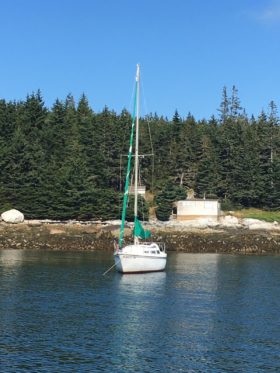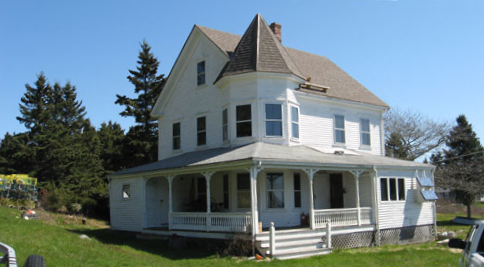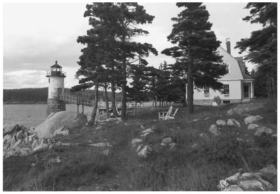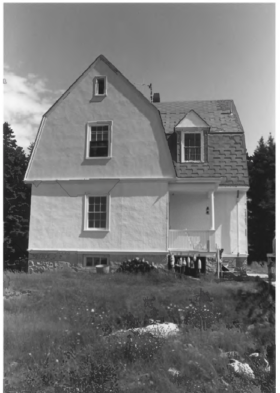| Year | Population |
|---|---|
| 1970 | 45 |
| 1980 | 57 |
| 1990 | 46 |
| 2000 | 79 |
| 2010 | 75 |
| Geographic Data | |
|---|---|
| N. Latitude | 44:00:32 |
| W. Longitude | 68:34:27 |
| Maine House | District 134 |
| Maine Senate | District 12 |
| Congress | District 1 |
| Area sq. mi. | (total) 109.5 |
| Area sq. mi. | (land) 12.7 |
| Population/sq.mi. | (land) 5.8 |
County: Knox
Total=land+water; Land=land only |
|
[ILE ah hoe] is a town in Knox County, incorporated on February 28, 1874 from a portion of Deer Isle from which it is separated by five miles of water.
Samuel de Champlain apparently named it in 1604 from the French for “high island,” concurring with a later observation by Captain John Smith who called it the highest island in Penobscot Bay.
The earliest settlers appear to have been Peletiah Barter from Boothbay, and his brothers Henry and William who arrived in 1792.
In November 1808, smugglers murdered a customs guard named Lazaro Bogdomovitch on Isle Isle Au Haut and cast his body adrift. Officials captured and jailed the perpetrators after a a harrowing sea chase, but a mob of men disguised as women attacked the Lincoln county jail an released most of the prisoners. At the ensuing trial the court was forced to let the remaining prisoners to go free because no witnesses would come forward. The federal court system finally apprehended two suspects and tried them, but one escaped and lived in exile for the rest of his life, and the other languished in prison until a drunken sailor murdered him in 1815. This account shows how much smuggling ruled the eastern coast from Isle AU Haut to Eastport at the time. **
In About half the island is incorporated into Acadia National Park, beginning with a gift from the Bowditch family of Isle au Haut Mountain. Ernest Bowditch came from Boston in 1880 and bought land on the island.
He and Albert Otis of Belfast invited some wealthy friends to form the Point Lookout Fishing Club. The result was a surge in summer cottages and the beginning of seasonal residents on the island.
Six miles long and two miles wide, its cliffs rise 550 feet above sea level. A narrow mile-long lake (variously know as Long Pond, Turner Lake, and Champlain Lake) hugs the southeastern corner of the island.
Isle au Haut is both a lobstering community and a retreat for seasonal cottage owners. It has also been home to author-fisherman Linda Greenlaw.
Brady G. Williams photos (2021)
Form of Government: Town Meeting-Select Board.
Additional resources
** Murder on Isle AU Haut: Violence and Jefferson’s Embargo in Coastal Maine, 1818-1809. Maine Historical Society. Histories Boundaries. Volume 39, 2000.
Bates, Arlo, 1850-1918. “Isle au Haut.” Outing Magazine. September, 1885.
Greenlaw, Linda. The Lobster Chronicles: Life on a Very Small Island. New York : Hyperion. c2002.
Simpson, Dorothy. The Maine Islands in Story and Legend.
Turner Family. Papers 1835-1886. Diaries, financial papers, photographs, postcard collection, and letters of an Isle au Haut family of the 19th century. Special Collections, Raymond H. Fogler Library, University of Maine, Orono.
*United States. Department of the Interior. National Park Service.”Gooden Grant House.” https://www.nps.gov/nr/feature/places/13000926.htm
“Isle Au Haut Light Station.” https://npgallery.nps.gov/pdfhost/docs/nrhp/text/87002265.PDF
National Register of Historic Places – Listings
Gooden Grant House
Gooden Grant was a lobsterman who lived and fished out of Head Harbor, the southernmost harbor on Isle au Haut. His career lasted over 75 years until he retired at age 84. His large, well-built and stylish home at a prominent location in Head Harbor attests to his financial success. It also signifies the historic importance of the local maritime economy. Grant built the house in 1911; he retired in 1961.
Gooden Grant was also larger than life, with stories of his life becoming legendary. Tales have been told both on and off the island. Years after his death his home is still known as Gooden Grant’s house. As the National Register notes: “Celebrated in song , captured in photographs and profiled in multiple publications, Grant became not only an iconic Maine lobsterman, but embodied the traits of rugged independence that were so important for survival on the Maine coast.*
Isle Au Haut Light Station
[Robinson Point, Isle Au Haut] The Isle Au Haut Light Station is the next to last complex of its type established in Maine. Built in 1907 on Robinson Point at the southern end of Isle Au Haut Thorofare, the Light was established as a guide to the adjacent sheltered harbor. Because of the rich fishing grounds along the lower East Penobscot Bay, the harbor at Isle Au Haut was the most convenient harbor of refuge for fishing trawlers. The Light was activated on December 30, 1907.
In 1934 the Light was automated and the buildings, with the exception of the tower, were sold. In 1987 the houses were part of a bed and breakfast inn.* [Kirk F. Mohney photos]











